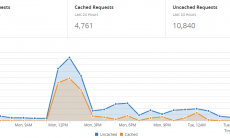While I aspire to build Gerr.is into a great empire, I’m currently interwoven into a patchwork of agencies, partners, clients, vendors, projects, goals, and even some very cool — but very geographically disparate — teams. It makes my head swim. It makes your head swim. Robots will enslave us all; however, until then, they make it possible to get quite a lot done on one’s own. An army of one, if you will. So, while I am building my empire, here are some of the tools I am looking at and using. This isn’t a review so much as simply a subjective sharing of some of the tools I use — and want to use — on a daily basis to make my work — and personal — life productive, collaborative, and organized. And, at the end of the day, if I love an app (such as Basecamp) but everyone else rejects it out of hand — and I can’t even threaten them into using it, either — then that’s an issue, too: the list below is also a list of productivity apps that the people with whom I work are already using, loving, and adopting (it’s a toss-up between Asana and Trello — currently, I am straddling them both, depending on task and what my clients are using). So, here we go.
Trello
Like the Mac, Trello seems too simple and elegant to actually be as powerful as it actually is It may be simple but it’s not simplistic. I am currently deeply besotted by Trello because the people behind this amazing, virtually completely free, project management app, Fog Creek Software, are generous to the point of “what!?” The app is completely free. Invite all of your friends and it’s still free. Create sophisticated projects with dozens of boards with an infinity of cards (they take the the bulletin board/index card analogy all the way, both visually and practically).
Heck, I’m using Trello to organize several projects with the founder and owner of this blog, Mike Moran. Trello accepts any rich content, it allows a couple ways to track tasks, both check boxes as well as “physically” moving cards from one board to another, from a “to-do” board to an “in progress” board and then to a “completed” or “done” board.
Every board allows sharing, tasking, commenting, and also uses the referencing tool that I believe was defined by Twitter. So, if you include @chris_abraham in a card, I’ll be notified (actually, Asana works the same way). The notification volume is as high as you want or need — and you can be notified about so many things.
You can also subscribe to any board you want, even boards that don’t really concern you (useful oversight if you manage the entire project). And why haven’t I been using Trello forever? Well, because I am sure none of the above makes much sense. Maybe that’s why Fog Creek not only gives it away but gives away a free month of their optional Trello Gold with every single person you recruit. So, if you click here and join Trello, you’ll earn me a free month of Trello Gold. The best part of Trello is that 80% of all of my clients love it, too. So, I can convince folks to get off of email and onto a project management platform with accountability, tracking, document sharing, tasking, and all that good stuff.
Finally, the Trello apps for iOS and Android are gorgeous and there’s even a version of Trello that’s compatible with that old iPad 1 you’ve pretty much given up on. The app is beautiful on my iPhone 5, Android Nexus 5 and 7, and also on my iPads 1 and Air. It’s even better mobile than on the web, IMHO. Unlike Evernote and Asana, I don’t believe Trello comes with an email you can use to send notes to Trello the way you can do with Asana and Evernote. That said, you can reply to a notification you receive via email via email and it’ll go where it should in your series of Boards and Cards.
Asana
For those of you who don’t know, an asana is a yoga position. Downward-facing dog is an asana. I really love everything about Asana except it’s just a little too complex for me to use, at least compared to Trello, and at least the way I am using it: free. If I were to spend $50/month, all my frustration would go away. Let me explain. Asana is free, sort of, if you hack it and work around some of the pay wall restrictions.
So, let’s talk Gerr.is, my company. Under my GERRISCORP.COM organization, I have a series of teams. Each team can have a number of members (for free) but without paying, there’s a catch: you can’t limit access for certain members to certain projects or tasks. Each team is an all or nothing venture. So, to management the 1U App project I am working on now, I needed to create separate teams for the campaign, one for the front office and one for the back office. So, my research and design team are invited to the 1U Back Office team and my colleagues Sally and Cokey have their own project, 1U Influencer Outreach.
If I hadn’t discovered Trello, I might have bit the bullet and paid up and paid the $504/year fee to make sure I could keep everything in once place: Team 1U with two or more projects, each project with its own unique permissions. I just discovered that you can pay your $504/year for either your entire organization (Gerris Corp) or for just one team, so you can break your needs apart, but there doesn’t seem to be a discount for paying for teams versus an entire organization. And then there’s Trello: people like it & it’s free.
I still love Asana. I can forward emails to x@mail.asana.com and they’re automagically turned into tasks. I can manage Asana via email. I will never leave Asana for my own personal tasking, however. Things that I need to do every day. Business Development and relationship management and things like writing Gerris’ capabilities deck or pimping my SquareSpace gerr.is website.
Essentially, I use Asana the way I should be using Evernote. I use it as the vessel that you’re supposed to dump all of your tasks into in order to clear your mind a la Getting Things Done. So, when I get an important email I can’t lose, I forward it to x@mail.asana.com. When I come up with a series of things I need to do, I dump it in my own space, either in Personal Projects or just in the Gerris team within my GerrisCorp organization. Dump, dump, dump. Like Trello, you can upload docs and photos, you can link to DropBox, you can call out other people by their name via Twitteresque @chrisabraham-type references. Asana has a gorgeous interface that wraps what’s really a very beautiful active text editor. You can write tasks as fast as you can type and hit return. If you want to break your lists into sections, just type a colon after your list heading and it’ll turn into one. Asana’s elegant and mostly unstructured so you can customise it into whatever you want. It’s being developed by some guru from Facebook so it’s elegant, smooth, gorgeous, and is constantly being updated and upgraded. Remember when I was crowing about how gorgeous the Trello apps are? Asana apps are possibly even nicer. I have a feeling, though, that I’ll really love Asana if and when I pay the fee, either $50/month or $504/year, but even so, it really is the world’s best collaborative, shareable, tasking, to-do, and task-based project management app out there. It’ll always be my GTD dump zone and I’ll always happily use it if my clients have a preference for it instead of Trello.
GetResponse
I have been a client of MailChimp for years but have never sent one email or newsletter. It’s powerful but what a pain in the bottom! I thought Aweber was impenetrable but MailChimp comes in #2. I want an app that’s at least as easy as SquareSpace to use, coming out of the box as response, wizard-driven, visual, and not requiring a designer, an SA, or a tech — with one caveat: also possessing all of the same power tools that the other email and mailing list management programs offer such as A/B testing, landing page creation, and sophisticated autoresponder tools. GetResponse seems to me to be the SquareSpace of newsletter and email list managers. In the past, email marketing seemed to me to be a life-sentence. Like blogging but less fun and less cool. GetResponse seems to get the tech out of the way and make it setting up pretty sophisticated autoresponder campaigns a breeze. Finally, GetResponse sends all of your messages using responsive templates. What that means is every GetResponse email automagically adapts itself to the platform on which you read the message, scaling to fit your phone, your tablet, or your desktop so that everything’s readable and easily navigable.
Toggl
back when I worked at Edelman, I hated keeping track of my time down to a 15-minute increment. Now, I live on Toggle. I track everything, even non-billables. It gives me an idea as to how I am spending (or misusing) my time. It also helps me understand better how many hours things take, something that can help me when it comes to pricing out proposals and projects in the future.
Toggl allows teaming, allows sharing, and the timer is integrated across all platforms of devices. I have Toggl installed on my iPhone 5, my Android Nexus 5 & 7, and on my desktop (although my desktop timer seems to be irrevocably broken — help, Toggl), and when I start tracking on my iPhone, I can stop it on the web or via any other device.
Toggl will let you know you left your timer on, it’ll pop you a note to ask you if you should be using the timer (a great reminder) and you can always pull reports from your exhaustive time-tracking, which is the perfect solution for a CYA situation if the client wants more accountability for your time and billing. Toggl allows you to set up clients, projects, and also tasks. You can be as granular as you like. Toggl with try to auto-complete with tasks you’ve done before, to make it easier. You can also tag everything, if that helps you stay organized. Each client and each project can be billed a different rates. So, I bill Wikipedia Management differently than I do ORM or SEO or SEM or influencer outreach or social media strategy.
Toggl also can link to other tools, such as BaseCamp, so that you can have your hours automatically synced over to your clients’ project management platforms. Actually, if you use the Toggl Button for Chrome, you’ll automagically have access to Toggl via Asana and Trello both. However, set it up to pester you incessantly because it only works if you work it, so work it.
Evernote
I want so desperately to use Evernote all the time and for everything. I don’t really use it much but I have been reading up on Evernote so what I am doing with Evernote is using it as a repository for all of the pages of all of my notebooks and journals. As a useful backup to having my bag lost of stolen. It’s a habit that’s hard-coming for me. So, here’s what I am doing with it:
- Photo backup all the pages in my notebooks right after I take the notes onto Evernote (hoping that the app does a little bit of handwriting recognition)
- Photograph all of my Post-It notes using the Post-It note photo frame (hoping for handwriting recognition)
- Taking photos of important documents
- Clipping important web pages that I want to keep (mostly recipes but hopefully more ideas for articles, columns, and blog posts)
- Photograph or clip articles, pages, and content that gives me business ideas or that I might want to give to prospects and clients.
What I like the most about Evernote is how many apps, plugins, and platforms Evernote has built up around the brand. From desktop app to a gorgeous web interface down to really easy-to-use and so simple to share to apps for iOS and Android (and I am sure Windows and Blackberry, too). Plus, like Trello, Evernote is super-generous with its premium version. While Evernote Premium costs only $5/month or $45/year, you can get loads of free months through getting your friends to join and by buying Evernote-braded kit, such as Evernote Moleskine pads or Evernote Post-It notes. Another thing I love about Evernote is that the app creates a bespoke, unique, email address that only you know that allows you to throw anything and everything into Evernote via email — any email. Asana needs to know all your email addresses in order to email them first; Evernote, on the other hand, doesn’t care, it only cares that you have access to the secret email address you’ve been given. There are even a cool series of codes you can embed into your subject line. For example, if you create this subject line:
Subject: 1U App response @gerris #1uapp #1u #blogger #influencer #reply
The note that’s created would be titled “1U App response” and it would be filed under the Gerris notebook and the note would be tagged with #1uapp #1u #blogger #influencer #reply, which could and should help you find that note later. Very cool.
I hope this list has been helpful to you. Please let me know what apps and services I have missed. What’s better than Toggl? What’s better than Asana and Trello? How should I be using Evernote? Any recommendations on videos, tutorials, or books on Evernote that might really make me an Evernote convert? Thank in advance and see you in the comments! Go git ’em, Tiger!







